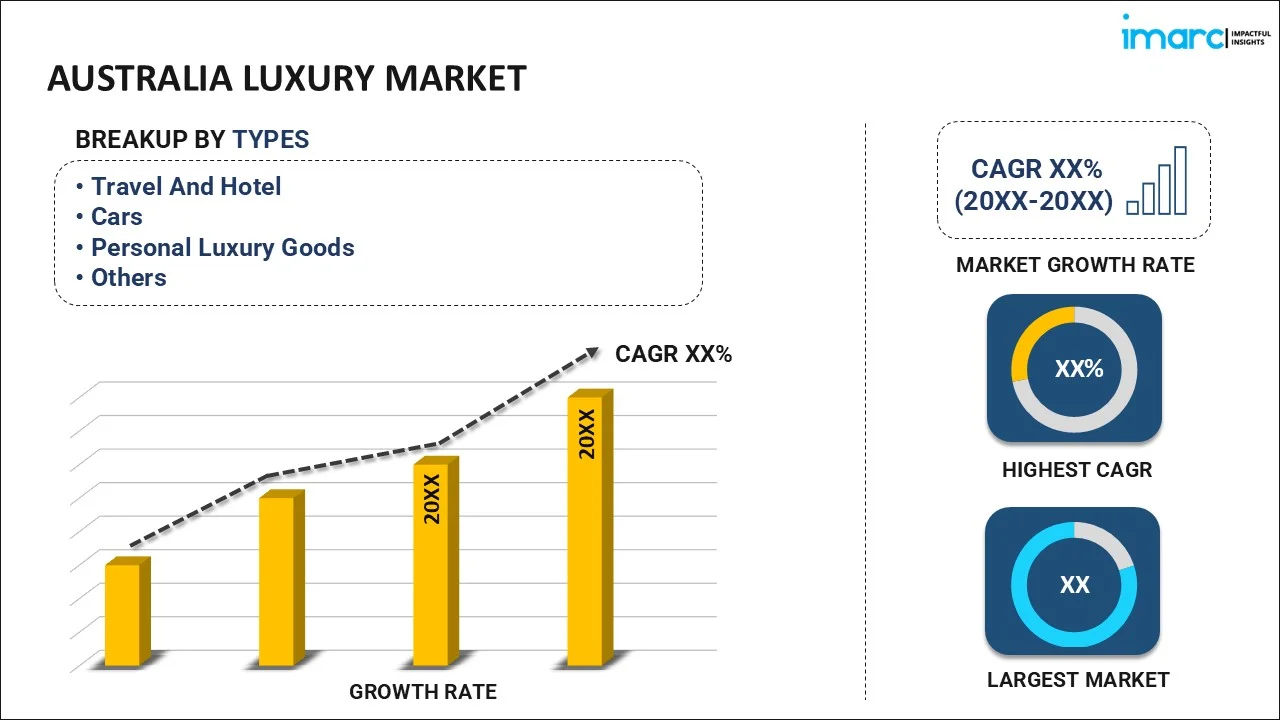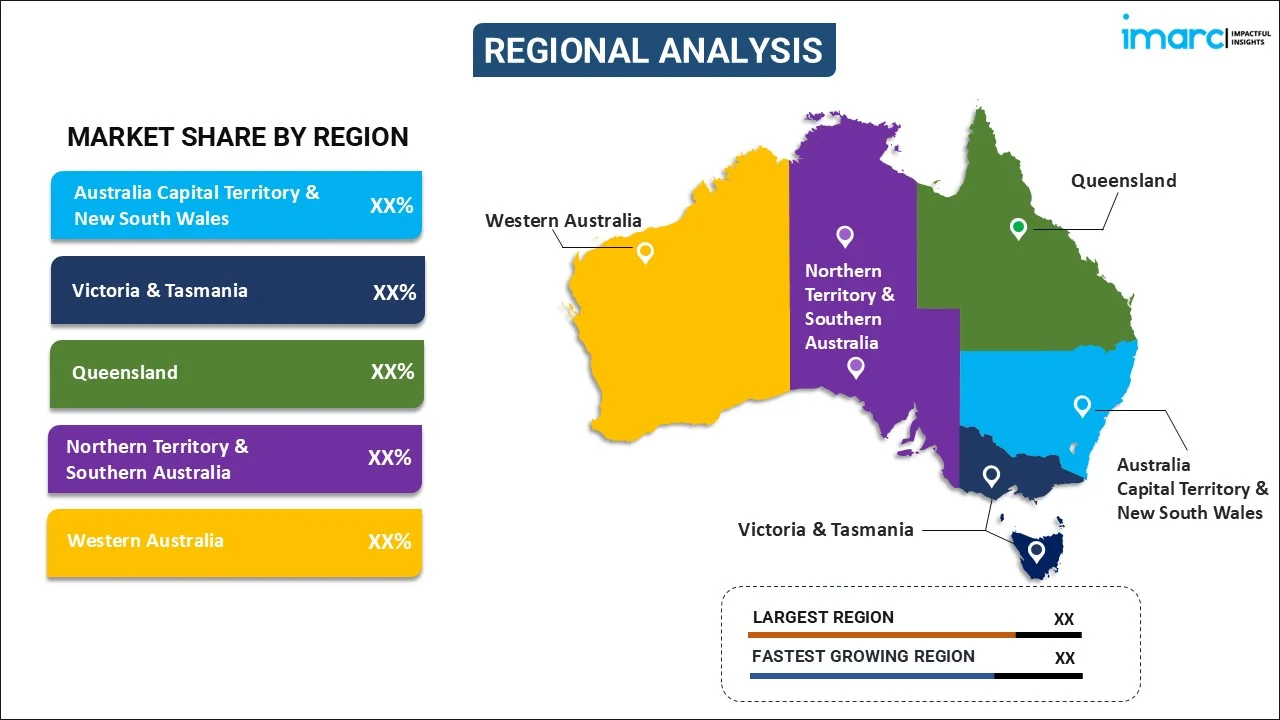
Australia Luxury Market Size, Share, Trends and Forecast by Type, Gender, Distribution Channel, and Region, 2025-2033
Australia Luxury Market Overview:
The Australia luxury market size reached USD 7.96 Million in 2024. Looking forward, IMARC Group expects the market to reach USD 15.39 Million by 2033, exhibiting a growth rate (CAGR) of 7.20% during 2025-2033. The Australia luxury market is driven by a growing high-net-worth population with rising disposable incomes, fueling demand for premium goods and exclusive experiences. Additionally, global luxury trends, influenced by digital media and international travel, shape consumer preferences, driving brand expansion, personalized offerings, and high-end retail growth across various luxury segments.
|
Report Attribute
|
Key Statistics
|
|---|---|
|
Base Year
|
2024 |
|
Forecast Years
|
2025-2033
|
|
Historical Years
|
2019-2024
|
| Market Size in 2024 | USD 7.96 Million |
| Market Forecast in 2033 | USD 15.39 Million |
| Market Growth Rate (2025-2033) | 7.20% |
Australia Luxury Market Trends:
Rise of Sustainable Luxury
Sustainability is becoming a defining trend in Australia’s luxury market as affluent consumers increasingly prioritize ethical and eco-friendly products. High-end brands are incorporating sustainable materials, responsible sourcing, and transparent supply chains to appeal to environmentally conscious buyers. Luxury fashion houses are emphasizing circular economy practices, such as recycling programs and biodegradable fabrics, while luxury automotive brands are introducing electric and hybrid models. In 2023, luxury retail trade in Australia reached a record AUD 6.2 billion, indicating a robust market for high-end products. Additionally, sustainable fine dining and eco-tourism experiences are gaining traction among affluent consumers seeking indulgence without environmental compromise. As regulatory policies and consumer expectations evolve, luxury brands are integrating sustainability as a core value, reshaping product offerings and marketing strategies to align with the growing demand for responsible luxury.
Personalization and Experiential Luxury
Australian luxury consumers are increasingly seeking personalized products and exclusive experiences that go beyond material goods. From bespoke fashion pieces to custom-built luxury vehicles, brands are leveraging advanced technologies such as AI-driven recommendations and virtual consultations to offer tailored services. High-end hospitality and travel sectors are also capitalizing on this trend by curating unique experiences, such as private yacht charters, luxury retreats, and exclusive fine dining events. Moreover, VIP concierge services and limited-edition collaborations further enhance exclusivity, reinforcing consumer loyalty. As personalization becomes a key differentiator, luxury brands are investing in data analytics and customer insights to refine their offerings, ensuring that each experience is tailored to individual preferences and lifestyles. However, Experiential luxury in Australia is expected to record a 6% value CAGR (at constant 2024 prices) over the forecast period, driven by shifting demographics and a growing preference for unique travel experiences.
Expansion of Digital and Omnichannel Retail
The digital transformation of Australia’s luxury market is accelerating, with brands enhancing their online presence and integrating omnichannel strategies. High-end retailers are investing in immersive digital experiences, such as virtual showrooms, augmented reality (AR) try-ons, and AI-powered personal shopping assistants. E-commerce platforms are becoming more sophisticated, offering seamless purchasing options and exclusive online collections. Additionally, social commerce through platforms like Instagram and WeChat is driving direct-to-consumer sales, particularly among younger affluent consumers. Luxury brands are also focusing on hybrid retail experiences, blending digital convenience with in-store exclusivity through appointment-only shopping, virtual styling sessions, and same-day delivery services. This omnichannel approach ensures seamless engagement across digital and physical touchpoints, enhancing customer experience and brand loyalty.
Australia Luxury Market Segmentation:
IMARC Group provides an analysis of the key trends in each segment of the market, along with forecasts at the region level for 2025-2033. Our report has categorized the market based on type, gender, and distribution channel.
Type Insights:

- Travel and Hotel
- Cars
- Personal Luxury Goods
- Food and Drinks
- Others
The report has provided a detailed breakup and analysis of the market based on the type. This includes travel and hotel, cars, personal luxury goods, food and drinks, others.
Gender Insights:
- Male
- Female
The report has provided a detailed breakup and analysis of the market based on the gender. This includes male and female.
Distribution Channel Insights:
- Monobrand Stores
- Multibrand Stores
- Online Stores
- Others
A detailed breakup and analysis of the market based on the distribution channel have also been provided in the report. This includes monobrand stores, multibrand stores, online stores, others.
Regional Insights:

- Australia Capital Territory & New South Wales
- Victoria & Tasmania
- Queensland
- Northern Territory & Southern Australia
- Western Australia
The report has also provided a comprehensive analysis of all the major regional markets, which include Australia Capital Territory & New South Wales, Victoria & Tasmania, Queensland, Northern Territory & Southern Australia, Western Australia.
Competitive Landscape:
The market research report has also provided a comprehensive analysis of the competitive landscape. Competitive analysis such as market structure, key player positioning, top winning strategies, competitive dashboard, and company evaluation quadrant has been covered in the report. Also, detailed profiles of all major companies have been provided.
Australia Luxury Market News:
- In January 2025, Ark Capital Partners, along with Lead Global and support from Pioneer Wealth, successfully acquired Melbourne Place Hotel. This acquisition marks the beginning of a new co-branded hotel fund, signaling a strategic partnership between Ark Capital Partners and Lead Global. The deal is seen as a significant step in both companies' growth strategies within the hospitality sector, with plans for further opportunities and successful transactions in the future.
- In April 2024, La Bottega acquired a majority stake in Vanity Group, a leader in designer hotel guest amenities, marking a major milestone in the luxury hospitality industry. La Bottega, known for its luxury toiletries with a strong Italian heritage, joins forces with Vanity Group, which recently earned B Corp certification. This acquisition brings together two industry giants with a shared vision of innovation and luxury, further strengthening their presence in the global hospitality market.
- In March 2024, Luxury Escapes launched its Luxury Escapes Agent Hub, a platform designed to help Australian travel agents access exclusive travel deals and streamline booking processes. The hub's launch follows significant interest from over 2,000 agents. Major Australian agency groups, including Savenio, itravel, and Australian Travel Agents Co-operative, have been onboarded to enhance the platform’s reach and offer agents seamless access to luxury travel products and services.
Australia Luxury Market Report Coverage:
| Report Features | Details |
|---|---|
| Base Year of the Analysis | 2024 |
| Historical Period | 2019-2024 |
| Forecast Period | 2025-2033 |
| Units | Million USD |
| Scope of the Report |
Exploration of Historical Trends and Market Outlook, Industry Catalysts and Challenges, Segment-Wise Historical and Future Market Assessment:
|
| Types Covered | Travel And Hotel, Cars, Personal Luxury Goods, Food and Drinks, Others. |
| Genders Covered | Male, Female |
| Distribution Channels Covered | Monobrand Stores, Multibrand Stores, Online Stores, Others. |
| Regions Covered | Australia Capital Territory & New South Wales, Victoria & Tasmania, Queensland, Northern Territory & Southern Australia, Western Australia. |
| Customization Scope | 10% Free Customization |
| Post-Sale Analyst Support | 10-12 Weeks |
| Delivery Format | PDF and Excel through Email (We can also provide the editable version of the report in PPT/Word format on special request) |
Key Questions Answered in This Report:
- How has the Australia luxury market performed so far and how will it perform in the coming years?
- What is the breakup of the Australia luxury market on the basis of type?
- What is the breakup of the Australia luxury market on the basis of gender?
- What is the breakup of the Australia luxury market on the basis of distribution channel?
- What are the various stages in the value chain of the Australia luxury market?
- What are the key driving factors and challenges in the Australia luxury market?
- What is the structure of the Australia luxury market and who are the key players?
- What is the degree of competition in the Australia luxury market?
Key Benefits for Stakeholders:
- IMARC’s industry report offers a comprehensive quantitative analysis of various market segments, historical and current market trends, market forecasts, and dynamics of the Australia luxury market from 2019-2033.
- The research report provides the latest information on the market drivers, challenges, and opportunities in the Australia luxury market.
- Porter's five forces analysis assist stakeholders in assessing the impact of new entrants, competitive rivalry, supplier power, buyer power, and the threat of substitution. It helps stakeholders to analyze the level of competition within the Australia luxury industry and its attractiveness.
- Competitive landscape allows stakeholders to understand their competitive environment and provides an insight into the current positions of key players in the market.
Need more help?
- Speak to our experienced analysts for insights on the current market scenarios.
- Include additional segments and countries to customize the report as per your requirement.
- Gain an unparalleled competitive advantage in your domain by understanding how to utilize the report and positively impacting your operations and revenue.
- For further assistance, please connect with our analysts.
 Inquire Before Buying
Inquire Before Buying
 Speak to an Analyst
Speak to an Analyst
 Request Brochure
Request Brochure
 Request Customization
Request Customization




.webp)




.webp)












